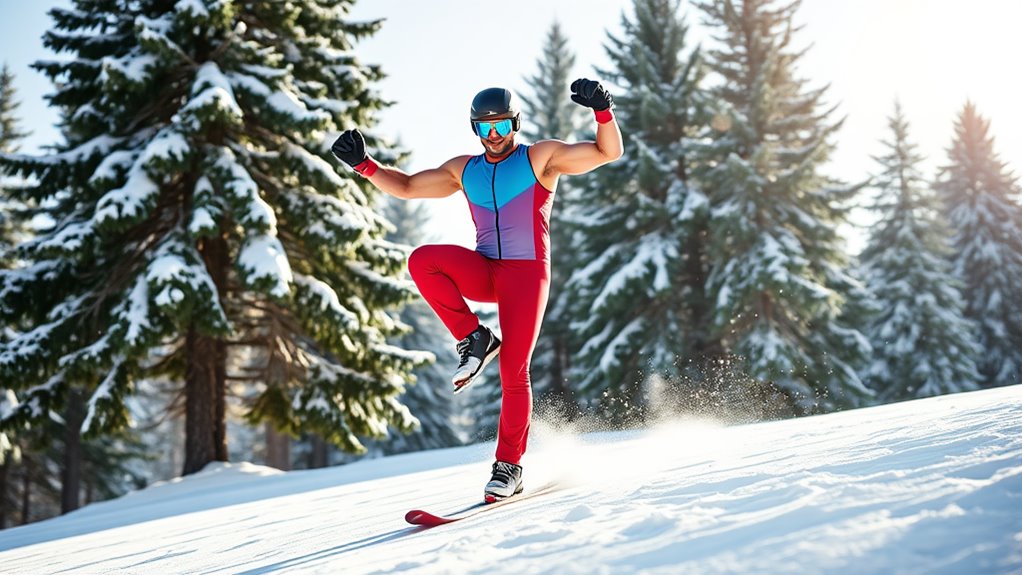To excel on the slopes, you need a workout routine that builds strength, balance, and core stability. Focus on your legs with squats and lunges while enhancing your core through planks and twists. Don’t forget upper body conditioning; strong shoulders and arms improve your control. Balance training, using boards and single-leg exercises, will enhance your stability. Incorporating flexibility into your routine helps prevent injuries. Keep going to discover more strategies for ski fitness and performance!
Nomad Highlights
- Focus on strength exercises like squats and lunges to build leg power essential for skiing performance and control.
- Incorporate core stability workouts such as planks and Russian twists to enhance balance and prevent injuries on the slopes.
- Use resistance bands for upper body conditioning to improve control and stability during skiing maneuvers.
- Include balance training techniques like single-leg exercises and balance boards to challenge stability and coordination.
- Design a ski-specific workout plan that combines strength, balance, and endurance training for optimal performance in the snow.
Understanding the Importance of Strength and Balance for Skiing
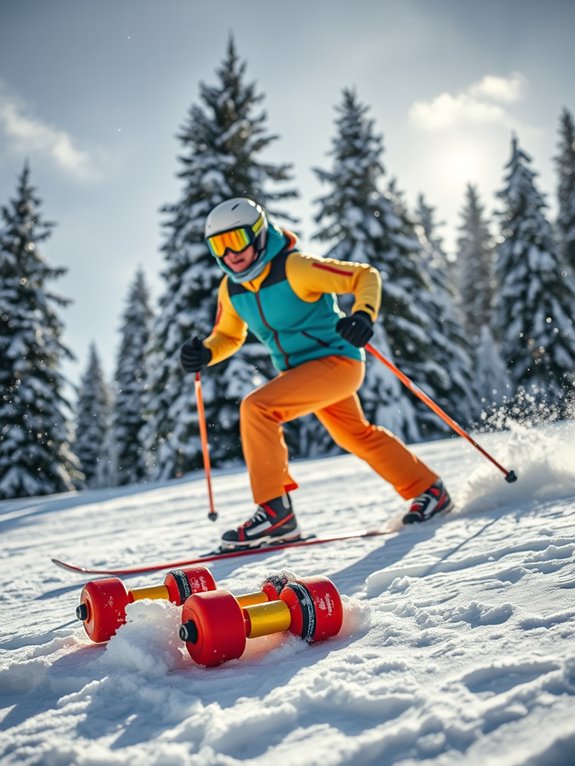
When it comes to skiing, strength and balance are more than just physical attributes; they’re the foundation of your performance on the slopes. Mastering effective skiing techniques requires a solid core and lower body strength to navigate varied terrains. By developing these attributes, you enhance your control, allowing you to execute sharp turns and maintain speed with precision. Additionally, engaging in unique products designed for skiing can provide you with specialized equipment that further supports your training. Resistance bands, for example, offer versatile tools for improving strength and flexibility, making them ideal for ski-specific workouts. Incorporating ankle resistance bands into your routine can significantly enhance your lower body strength and stability. Furthermore, utilizing compact foam rollers can aid in muscle recovery, ensuring you stay limber and ready for your next run.
Additionally, focusing on strength and balance plays a vital role in injury prevention. A strong body can absorb the impacts of steep descents and unpredictable snow conditions, reducing your risk of falls and strains.
Embracing innovative training methods, like balance boards or plyometric exercises, can elevate your skiing game, making each descent more enjoyable and less taxing on your body. Incorporating resistance bands into your workouts can further enhance your strength training regimen, providing versatile options for targeting different muscle groups.
Key Muscle Groups to Target in Ski Workouts
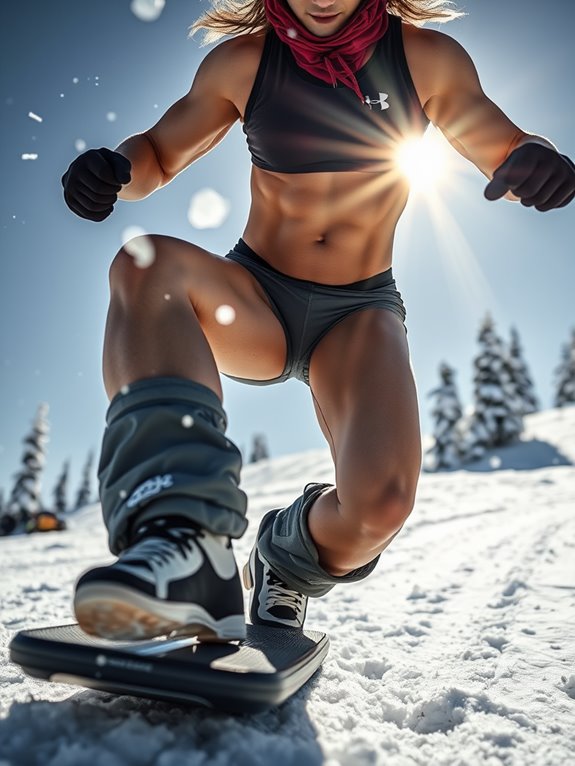
To ski effectively, you need to focus on key muscle groups that enhance your performance. Prioritizing core stability, leg strength, and upper body conditioning will help you tackle the slopes with confidence and control. Incorporating resistance bands into your training routine can further improve your strength and flexibility for skiing. Additionally, utilizing a fitness tracker with 24/7 health monitoring can help you keep track of your overall performance and recovery as you train. Implementing adjustable resistance settings in your workouts can also simulate the varied intensities you’ll encounter on the slopes. Consistent use of a fitness tracker can provide insights on heart rate monitoring, allowing you to better understand your exertion levels during training sessions. Tracking your progress with a device that offers over 120 sports modes can help you diversify your workouts and stay motivated.
Core Stability Training
Core stability is essential for enhancing your skiing performance and preventing injuries on the slopes. By focusing on core engagement, you can improve your balance and control while carving turns or traversing challenging terrain. Additionally, incorporating a compact foam roller can further aid in muscle recovery, allowing you to maintain your strength and flexibility for optimal performance on the mountain. A dual-wheel design in your fitness equipment can enhance stability and balance, crucial for effective core workouts. Using a foam roller can also help enhance flexibility before and after workouts, ensuring your muscles are well-prepared for skiing. Engaging in targeted muscle training can significantly boost your overall skiing ability.
Incorporate stability drills into your training regimen to strengthen the muscles that support your spine and pelvis. Exercises like planks, Russian twists, and bird-dogs are fantastic for building a solid foundation. Additionally, utilizing a stretching strap can further enhance your flexibility and recovery, ensuring that your muscles are primed for optimal performance on the mountain.
Remember, a strong core helps you maintain proper posture and absorb shocks, making your skiing experience smoother and more efficient. Integrate these innovative workouts into your routine, and you’ll notice a marked improvement in your stamina and agility on the mountain.
Embrace core stability training, and elevate your skiing to new heights!
Leg Strength Exercises
While skiing demands a combination of skills, having strong legs is essential for maintaining control and power on the slopes.
To build leg strength, focus on squat variations like sumo squats and jump squats, which target your quads, hamstrings, and glutes. Incorporate lunges progression into your routine—start with basic lunges and advance to reverse and lateral lunges. Additionally, using an acupressure mat can aid in muscle relaxation after intense workouts, helping to alleviate soreness and improve recovery. Ergonomic designs in writing instruments can also enhance your overall comfort during long training sessions, just as they do for individuals with writing challenges. Furthermore, investing in a chair with adjustable lumbar support can provide essential comfort during your recovery and rest periods. Proper lumbar support cushions can significantly enhance your back health during these recovery times. This not only enhances strength but also improves balance, vital for maneuvering uneven terrain. Additionally, consider plyometric exercises to boost explosive power. Regular use of acupressure mats can complement your training by promoting muscle relaxation and pain relief.
Aim for three sets of 10-15 reps for each exercise, gradually increasing intensity. By consistently targeting these key muscle groups, you’ll enhance your skiing performance and enjoy a more exhilarating experience on the mountain.
Upper Body Conditioning
Although skiing often emphasizes leg strength, upper body conditioning is equally important for overall performance and stability on the slopes.
By targeting key muscle groups like your shoulders, back, and arms, you can enhance your upper body strength, which plays a vital role in maintaining balance and control while skiing.
Integrating exercises such as push-ups, rows, and medicine ball twists into your routine will help you develop the necessary power for effective ski pole techniques.
Strong arms allow you to maneuver your poles with precision, improving your rhythm and efficiency.
Don’t overlook your upper body in your training regimen; it’s essential for carving those perfect turns and tackling challenging terrains with confidence. Additionally, investing in quality workout gear can further support your training efforts and improve your overall skiing performance.
Essential Strength Exercises for Skiers
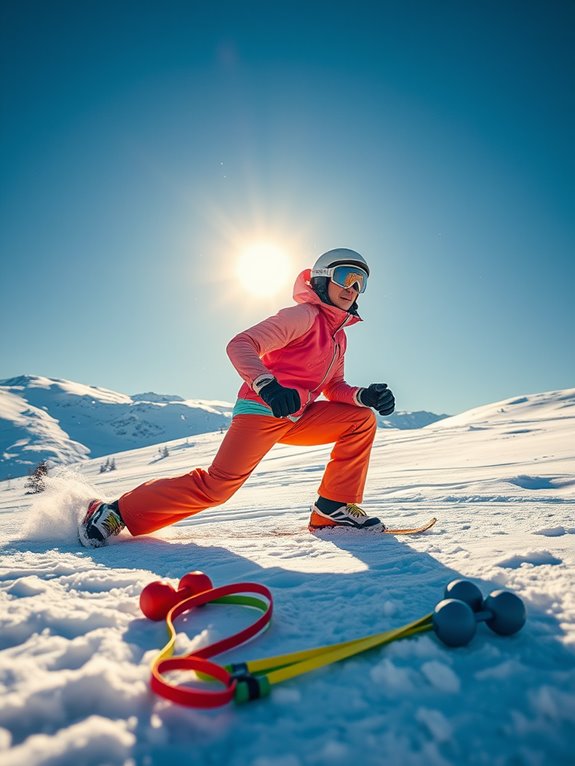
To excel on the slopes, you need to focus on strength exercises that target key muscle groups essential for skiing. Begin with squats to build your quads and glutes, ensuring powerful turns and quick responses. Add lunges for balance and stability, mimicking the pressures you’ll face while skiing. Incorporate deadlifts to strengthen your posterior chain, which supports injury prevention during those demanding runs. Additionally, using adjustable dumbbells allows for versatile weight options that can enhance your training by accommodating different strength levels. These weights can be particularly beneficial for customizable weight options, helping you gradually increase resistance as your strength improves. Including exercises with portable kettlebells can also improve your overall strength and stability, especially when traveling or training in limited space. Don’t forget to include core exercises like planks and rotational movements to enhance stability and control. Resistance bands, which are effective for strength training, can also be utilized to add variety and intensity to your workouts. Alongside these workouts, prioritize skiing nutrition to fuel your body, optimizing performance and recovery.
Balance Training Techniques to Enhance Ski Performance
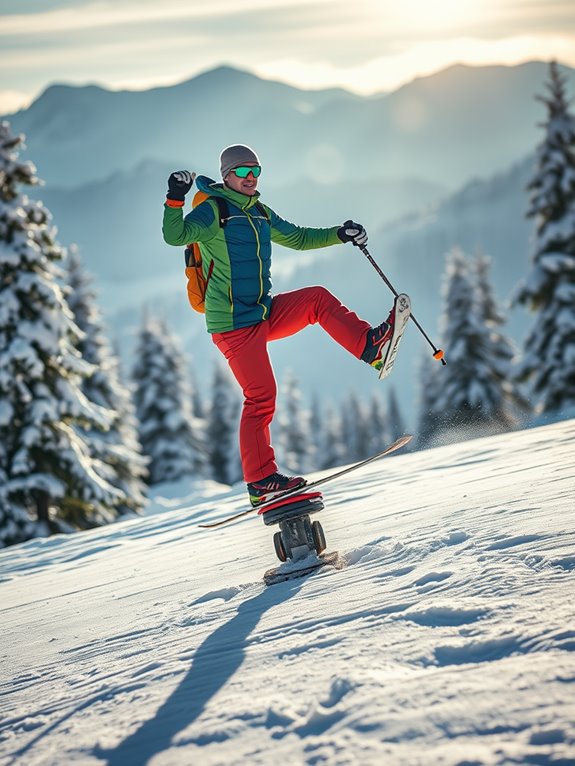
As you prepare to hit the slopes, incorporating balance training into your routine can greatly enhance your skiing performance. Including unique products designed for balance training can make your workouts more effective and enjoyable.
Focus on specific balance drills that challenge your core and lower body stability. One effective technique is the single-leg balance exercise, where you stand on one leg while maintaining control and composure. You can elevate the challenge by closing your eyes or using an unstable surface like a balance board. Balance boards, such as the HAPOO Balance Board, are ideal for beginners and can help improve your stability during workouts. Additionally, integrating exercises that utilize agility ladders can further enhance your coordination and foot speed. Including exercises that promote adjustability and height range can also contribute to overall strength and balance.
Incorporating core stability exercises into your routine can also significantly improve your overall performance on the slopes. Stability exercises, such as squats on one leg or lateral lunges, also build the strength needed for quick adjustments on the slopes.
Incorporating Flexibility and Mobility Into Your Routine

Incorporating flexibility and mobility into your ski workout routine is essential for preventing injuries and improving performance. Stretching helps increase your range of motion, while dynamic mobility exercises prepare your body for the demands of skiing. Additionally, incorporating guided meditation can enhance your mental focus and promote relaxation, which is crucial for optimal performance on the slopes. By utilizing structured guidance in your meditation practice, you can foster a deeper sense of mindfulness that complements your physical training. Regular practice of guided imagery audio tracks can also reinforce stress reduction and foster positive thinking patterns, further benefiting your skiing experience. Consider using aromatherapy inhalers during your recovery sessions to enhance relaxation and support respiratory function.
Importance of Stretching
While skiing demands strength and endurance, the importance of flexibility and mobility shouldn’t be overlooked. Incorporating effective stretching techniques into your routine can enhance your performance and reduce the risk of injury.
By focusing on various muscle groups, you’ll experience flexibility benefits that improve your range of motion. This increased mobility allows you to navigate challenging terrain with greater ease and confidence.
Try dynamic stretches before hitting the slopes to warm up your muscles, and static stretches afterward to aid recovery.
Dynamic Mobility Exercises
To maximize your skiing performance, integrating dynamic mobility exercises into your routine is essential. Dynamic stretching and mobility drills enhance your flexibility, allowing for smoother movements on the slopes.
Start with leg swings to loosen your hips and improve your range of motion. Incorporate walking lunges with a twist to engage your core and legs simultaneously. Try high knees and butt kicks to activate your lower body muscles effectively.
These exercises not only prepare your body but also help prevent injury by increasing blood flow. By consistently incorporating these dynamic mobility exercises, you’ll notice improved balance and agility, enabling you to tackle any terrain with confidence and style.
Get out there and stretch your limits!
Designing a Ski-Specific Workout Plan
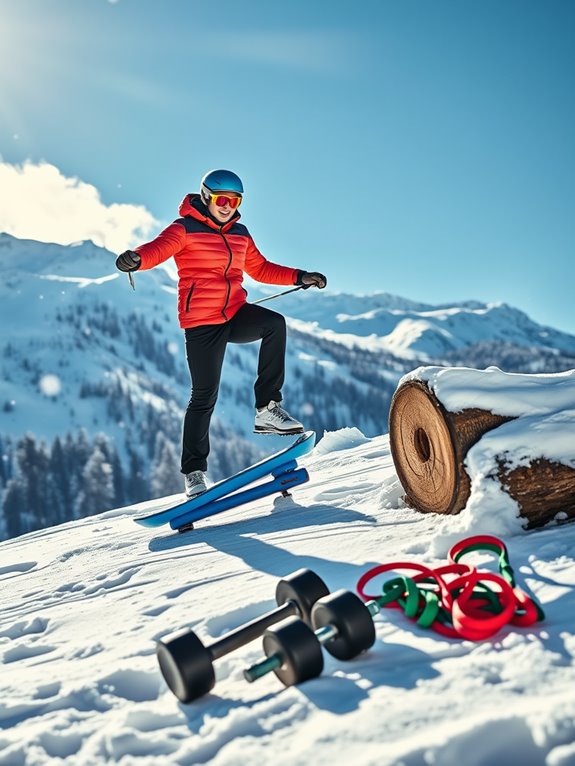
A well-structured ski-specific workout plan is essential for enhancing your performance on the slopes.
Focus on building strength, balance, and endurance to master skiing techniques effectively.
Consider these key components when designing your plan:
- Strength Training: Incorporate exercises like squats and lunges to build lower body power.
- Balance Work: Use stability boards or single-leg exercises to improve your core stability.
- Endurance Conditioning: Include cardio workouts, such as cycling or running, to boost your stamina.
- Workout Duration: Aim for 45-60 minutes per session, adjusting intensity as you progress.
Tips for Staying Motivated and Consistent in Your Training
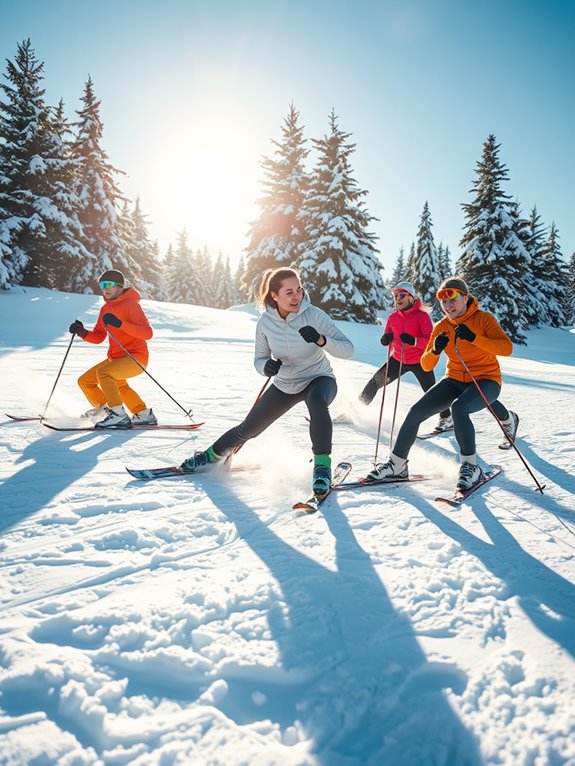
Staying motivated and consistent in your ski training can be just as important as the workouts themselves. Start by setting clear, achievable goals. Break them down into smaller milestones to track your progress and celebrate small victories along the way. This keeps your motivation high and your focus sharp.
Consider finding an accountability partner—someone who shares your passion for skiing and can join you in workouts or check in on your progress. This relationship can create a supportive environment, making it easier to stick to your routine.
Finally, mix up your training to keep things fresh and exciting. Incorporating new exercises or challenges won’t only enhance your skills but also reignite your enthusiasm for training.
Frequently Asked Questions
How Often Should I Train for Skiing Throughout the Year?
To maximize your skiing performance, aim for consistent ski training frequency throughout the year.
Ideally, you should train at least three to four times a week, mixing strength, balance, and endurance exercises. Year-round preparation keeps you physically ready and helps prevent injuries.
Incorporate activities like cycling or running during the off-season to maintain cardiovascular fitness.
Staying diligent with your training guarantees you hit the slopes strong and confident when the snow falls.
Can I Ski Without Doing Specific Strength Training?
You might think you can ski without specific strength training, but that could limit your performance.
Balance exercises and ski conditioning are essential for mastering those turns and maneuvering tricky terrain.
While you can hit the slopes occasionally, building strength and improving your balance will enhance your experience and reduce injury risk.
What Equipment Do I Need for Ski Workouts at Home?
To set up an effective home gym for ski workouts, you’ll want some essential equipment.
Start with resistance bands for strength training, a stability ball for balance, and dumbbells to build muscle.
A foam roller is great for recovery, while a jump rope can enhance your cardio.
Don’t forget a sturdy mat for floor exercises.
With these workout essentials, you’ll create a versatile space that keeps you fit and ready for the slopes.
Are There Age Restrictions for Ski-Specific Training Programs?
When it comes to ski-specific training programs, think of them as a tailored suit—fitting for all ages.
Most programs welcome participants from youth to seniors, adjusting methods to suit different abilities. Youth programs often focus on foundational skills, while senior adaptations emphasize balance and joint care.
These age-specific variations guarantee everyone can shred the slopes safely and effectively.
How Do I Prevent Injuries While Training for Skiing?
To prevent injuries while training, focus on injury prevention strategies.
Start with effective warm-up routines that increase your heart rate and flexibility. Incorporate dynamic stretches and movements mimicking skiing to prepare your muscles.
Strength training is vital; target your legs, core, and balance with exercises like squats and lunges.
Listen to your body, and don’t push through pain. Staying hydrated and maintaining proper nutrition also play essential roles in keeping you injury-free during training.
Conclusion
To maximize your skiing performance, focusing on strength and balance is essential. Did you know that skiers who incorporate strength training into their routines can improve their performance by up to 20%? By targeting key muscle groups, practicing balance techniques, and maintaining flexibility, you’ll not only enhance your skills on the slopes but also reduce your risk of injury. So, commit to your ski-specific workout plan and enjoy a more powerful, confident ride this season!

